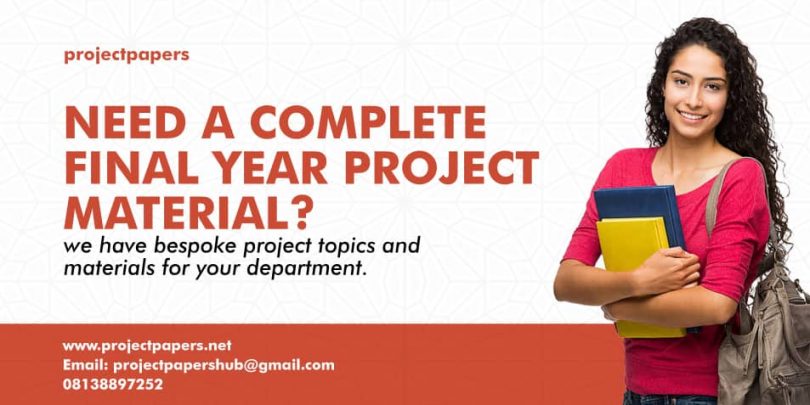Advertisements
Recycling Waste Polyethylene Materials to Useful Products via Pyrolysis
Content Structure of Recycling Waste Polyethylene Materials to Useful Products via Pyrolysis
- The abstract contains the research problem, the objectives, methodology, results, and recommendations
- Chapter one of this thesis or project materials contains the background to the study, the research problem, the research questions, research objectives, research hypotheses, significance of the study, the scope of the study, organization of the study, and the operational definition of terms.
- Chapter two contains relevant literature on the issue under investigation. The chapter is divided into five parts which are the conceptual review, theoretical review, empirical review, conceptual framework, and gaps in research
- Chapter three contains the research design, study area, population, sample size and sampling technique, validity, reliability, source of data, operationalization of variables, research models, and data analysis method
- Chapter four contains the data analysis and the discussion of the findings
- Chapter five contains the summary of findings, conclusions, recommendations, contributions to knowledge, and recommendations for further studies.
- References: The references are in APA
- Questionnaire
Advertisements
INTRODUCTION
Background of study
Recycling is a process of changing waste materials into new products to prevent waste of potentially useful materials, reduce the consumption of fresh raw materials, energy usage, water and air pollution (from incineration), and lower greenhouse gas emissions as compared to plastic production. Recycling is a key component of modern waste reduction and is the third component of the “Reduce, Reuse and Recycle” waste hierarchy (lajeunesse,sara 2004).
The rate of consumption of plastic materials in the world is greatly expanding, more waste plastics are generated. In recent years, their generation amount in Korea becomes about four million per year, according to data from the National Institute of Environmental Research (Lajeunesse, Sara 2004). The disposal of waste plastic is mostly achieved by conventional ways such as landfill or incineration. However, these methods have a problem of a social resistance due to the air pollution, soil contamination, and the economical resistance caused by an increase of space and disposal cost. Thus, the recycling of plastic wastes as a cheap source of raw materials has become a predominant subject over all countries (Roach, John 2003). The development of technologies acceptable from the environmental and economical fields is one of the most important key factors. (Roach, John.2003). Plastic materials used for food storage, visible in all supermarkets, preserves freshness and flavor due to the ability to seal out contaminants. Polyethylene materials are useful over a wide temperature range, from frozen foods to microwavable packages1. Due to these benefits, plastics have become widely used. (lajeunesse,sara 2004).
Polyethylene plastic bags are petroleum-based so the manufacturing process releases harmful pollutants into the atmosphere. Some speculate that these emissions and other smog-related types of pollution accumulate over time in the atmosphere.
Countries and large corporations are beginning to realize the threat that these plastic bags pose to our planet. Many are proposing or have already enacted laws and taxes to decrease the use of polyethylene plastic bags. Many grocery stores are even rewarding customers for bringing reusable grocery bags as an alternative to these polyethylene plastic bags. Customers choosing not to use alternatives to plastic bags either find the alternatives are inconvenient or are simply unaware of the problem at hand.
Polyethylene recycling bags are currently being used all over the world but there is currently no environmentally friendly way to dispose of them.
AIM
The aim is to obtain useful materials by recycling waste polyethylene materials via pyrolysis.
OBJECTIVES
The objectives of this work are:-
i. To collect the polyethylene waste materials (discarded water sachets and plastic bottles e.tc.).
ii. To carry out thermal pyrolysis of the materials at a temperature of 350oC – 400oC
iii. To analyze each residue for toxic metals
iv. To use ‘fresh’ and ‘spent’ FCC catalyst within the range of 350oC – 400oC
v. To monitor the quantity of fuel gases and hydrocarbon liquids evolved.
SIGNIFICANCE OF THE STUDY
The significance studies of the recycling polyethylene waste materials via pyrolysis are :-
- It helps in prevent waste pollutants from an environment.
- The recycling of polyethylene waste help in an industrial production of plastic and other polymer products, such as sachet water, plastic bottles, rubber paint etc as sources of raw materials to produce other useful products from those polyethylene waste materials.
- It serve as an economics important to the society or nations.
- Recycling is a dynamic process that restores the life of a material after used.
- The recycling of polyethylene waste Materials to useful products appear interwoven with our consuming society where it would be hard to imagine a modern society today without plastics which have found amyriad of uses in fields as diverse as household appliances, packaging, construction, medicine, electronics, and automotive and aerospace components.
- It helps to convert some polymer into paraffins and olefins
SCOPES OF THE STUDY
The research is restricted to the polyethylene waste products, arising specifically from High Density polyethylene (HDPE) polyethylene and LDPE.No attempt is made to suggest new production processes. The study does not include investigation of alternative materials.
Advertisements


